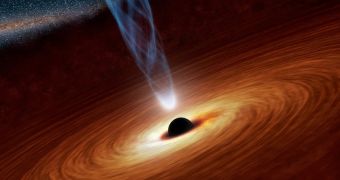Learning new things about the Universe is always fascinating, and so is a new discovery made regarding the black holes that pepper space.
Astronomers have watched a black hole that sits at the core of a spiral galaxy some 500 million light years from Earth. The gas and dust from its surroundings have been sucked in, as it normally happens, but the close eye kept on the place revealed new information.
By measuring the distance between the inner edge of the disk and the black hole allowed them to estimate the black hole’s spin, Space.com reports.
This has only been done a few times before and with greater effort, as well as through a different method.
Previous attempts measured the distortion of high-energy light emitted by iron atoms in the accretion disk.
"If a black hole is spinning, it drags space and time with it, and that drags the accretion disk, containing the black hole's food, closer towards it. This makes the black hole spin faster — a bit like an ice skater doing a pirouette," the study’s lead author, Chris Done, said.
The study shows that the black hole in question has a relatively low spin rate.
The method could help astronomers answer many questions about the galactic evolution.

 14 DAY TRIAL //
14 DAY TRIAL //